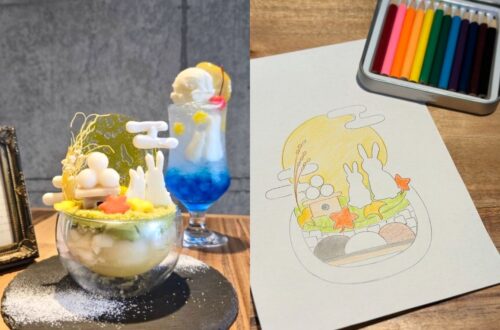
Osaka Namba Food Recommendations | Popular Seafood Izakaya from Kyoto – Sushitofuji Namba, No Otoshi Required 鮨酒場 スシトフジ なんば
Hailing from Kyoto, the renowned seafood izakaya, Sushitofuji, has planted its flag in Osaka’s bustling Namba district as of April 2024. Renowned for serving up delicious sushi at affordable prices, this establishment has garnered fame for its fresh and reasonably priced seafood. Not only does it waive the customary “otoshi” charge, but it also offers discounted beer starting at a mere 199 yen. With menus available in Japanese, English, and Chinese, even overseas visitors unfamiliar with Japanese can easily place their orders. From sushi to sashimi, and from eel to chawanmushi (steamed egg custard), it’s a one-stop shop to check off your list of must-try Japanese cuisines!
English is not my native language, but I am currently learning it. I am attempting to write articles in English to help others who may be searching for information. Some sentences might sound awkward or unusual, and I hope you understand. I welcome any questions you may have, and I’ll be happy to respond.
Popular Seafood Izakaya from Kyoto – Sushitofuji Namba 鮨酒場 スシトフジ なんば

Sushitofuji Namba (鮨酒場 スシトフジ) is a popular seafood izakaya hailing from Kyoto and is part of the “Tai no Tai” seafood izakaya series. The establishment first opened its doors in Kyoto in 2023 and has quickly become a favorite among locals and visitors alike, despite being in operation for just over a year. In April 2024, it expanded its reach to Osaka’s bustling Namba district.

Conveniently located near Nipponbashi subway station, Sushitofuji Namba is just a minute’s walk away.

Exiting the subway station and heading towards Sennichimae Central Avenue, as night falls, the vibrant nightlife of Japan begins to unfold. Along the way, you’ll hear the enthusiastic calls from various izakayas, creating an atmosphere filled with warmth and energy throughout the neighborhood.

鮨酒場 スシトフジ Sushitofuji is situated on the second floor, with its impressive facade catching the eye. The ground floor hosts a popular yakiniku (grilled meat) restaurant, and as you ascend the staircase from the entrance, you’re greeted with welcoming signs in various languages, reflecting the establishment’s friendliness towards foreigners.
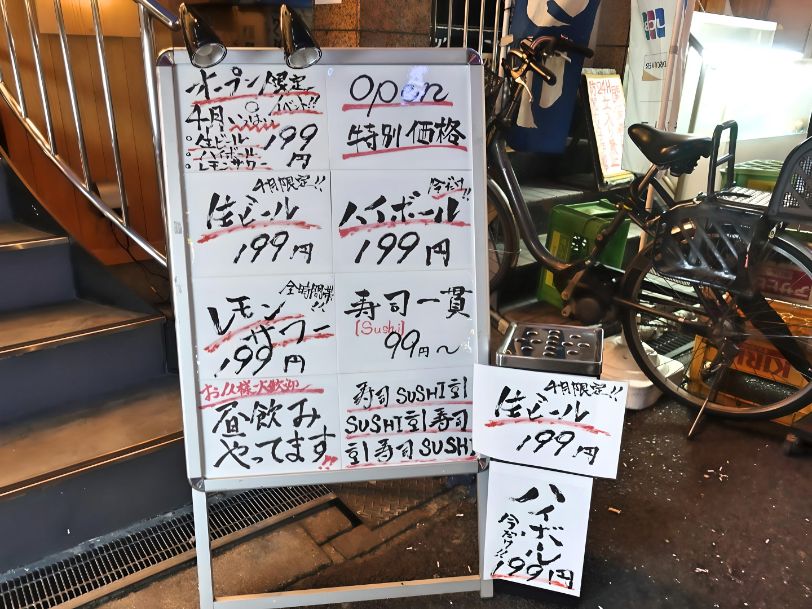
The menu displayed at the entrance is simple yet inviting, with items such as draft beer, lemon shochu at the opening special price of 199 yen, and sushi sets ranging from 99 yen, making it a budget-friendly option among izakaya dining experiences.
| Sushitofuji Namba Address: 2F, 2-5-7-2 Sennichimae, Chuo-ku, Osaka Phone: 06-6647-6230 Opening Hours: Mon-Fri 17:00 – 23:30, Sat-Sun 12:00 – 15:00, 16:00 – 23:30 Instagram Click here to make a reservation |
No Otoshi Required

For those who enjoy izakaya culture, the term “otoshi” (お通し) should ring a bell. Otoshi refers to the appetizer served at izakayas after ordering the first drink, typically functioning as a table charge or minimum order requirement. Otoshi commonly includes cold dishes like pickles or salad, sometimes featuring the establishment’s specialty dishes. At Sushitofuji Namba, there’s no otoshi, so you no longer need to worry about unexpectedly high minimum charges eating into your budget.
Interior Ambiance of Sushitofuji Namba

As one might expect from its impressive facade, the interior of Sushitofuji Namba is equally remarkable, offering a spacious and awe-inspiring dining environment.

Unlike the cramped spaces often found in typical izakayas aiming for maximum occupancy, Sushitofuji boasts a generously sized interior that comfortably accommodates over 60 patrons.

In addition to counter seating, the establishment provides large communal tables. I particularly enjoyed these seats, complete with tabletop goldfish tanks for added charm.

During my visit, I was seated in a cozy booth with partition curtains, some of which were conveniently equipped with power outlets for guests’ convenience.


Moreover, there are also tables available for groups of four or two.

With its semi-open kitchen design, diners can enjoy watching skilled chefs craft their dishes, adding to the dining experience. Furthermore, the restaurant maintains a clean and tidy environment, ensuring a sense of comfort and peace of mind while enjoying their meals.
Welcome to Non-Japanese Speaking Overseas Visitors – Multilingual Menu in Japanese, English, and Chinese

When visiting a Japanese izakaya, nothing is more daunting than encountering high minimum charges and struggling to decipher the menu. However, Sushitofuji offers solutions. They provide physical menus in Japanese and offer a mobile ordering system where patrons can simply scan the QR code on their table with their phones to place orders. The web interface for mobile ordering requires LINE login and offers menus in multiple languages, although some translations might seem a bit literal. Nonetheless, it’s incredibly convenient and user-friendly for foreign visitors, especially for those who may feel anxious about face-to-face interactions.

The menu is diverse, featuring sushi, sashimi, various side dishes, and oden (a type of Japanese hot pot), encompassing a wide range of must-try Japanese delicacies, all made with fresh ingredients sourced from across Japan.

Their drink selection includes renowned beverages from different regions of Japan.

For non-alcoholic options, they also offer Ehime’s famous mandarin orange juice.
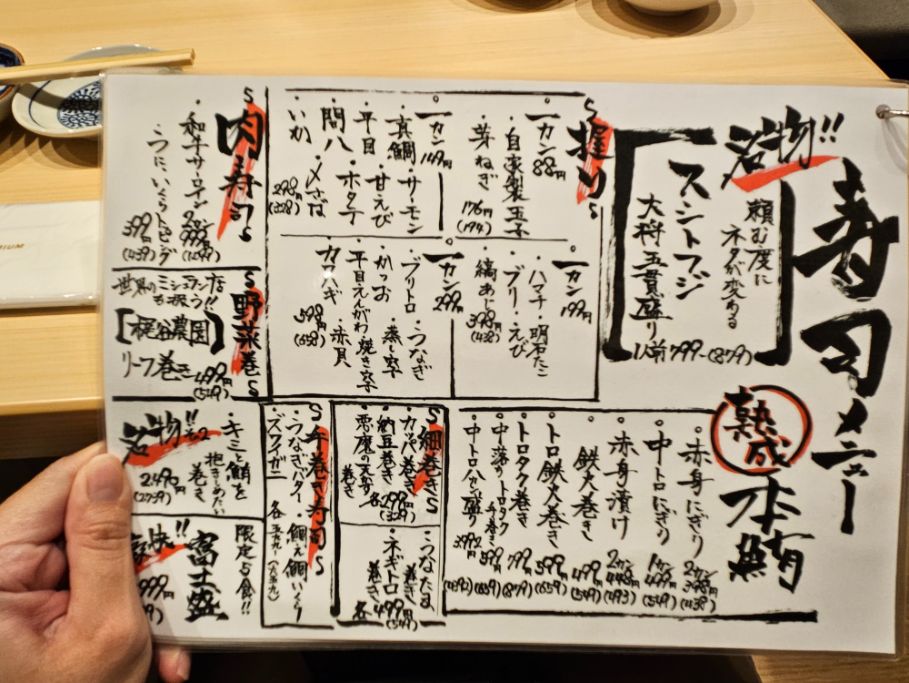
For first-time izakaya visitors unsure of what to order, selecting from the recommended menu is the simplest approach. Sushi sets range from as low as 88 yen to 299 yen. We opted for several items labeled as “名物” on the sushi menu, which unsurprisingly turned out to be the restaurant’s signature dishes!
◆君と鮪を抱きしめたい巻き

Let’s start by introducing my favorite sushi roll from this visit, the “Embrace Sushi.” The name itself is quite romantic, derived from a pun in Japanese where “you” sounds similar to “kimi,” which also means egg yolk. This sushi roll may appear ordinary at first glance, but it actually contains four different types of sashimi and salmon roe, along with spring onions and raw egg yolk!

Before it’s served, they’ll bring it out to show you the rich ingredients. Once it’s on the table, the filling practically spills out. Not only does it have a cute name and an enticing appearance, but the overall taste is also incredibly rich. The burst of egg yolk and the various sashimi blend perfectly, making it ideal for sharing among friends.
◆ Chef’s Recommended Five-Piece Sushi Selection 大将のオススメ五貫

When you’re here, you absolutely cannot miss out on their sushi! The “Chef’s Recommended Five-Piece Sushi Selection” is a specialty sushi set recommended by the chef. If you’re indecisive about sushi ordering, let the chef make the decision for you!

The “five-piece serving” includes tuna, salmon, and other seasonal fish such as sea bream and yellowtail. Even if you reorder, you’ll get different types of sushi each time!

Their specialty “aged tuna” undergoes a special aging process, resulting in a softer texture, richer flavor, and more complex taste. Previously, I only enjoyed salmon sushi, but after trying various types of fish here, salmon’s top spot is now in jeopardy!
◆Mount Fuji Sushi – Fuji Supreme, Limited to Five Servings Daily-豪!富士盛

The Fuji Supreme is one of their signature dishes, limited to just five servings per day. Its appearance alone is captivating, with the sushi arranged to resemble Japan’s iconic Mount Fuji. In addition to the assortment of sashimi, it’s adorned with glistening salmon roe, crab meat, and tamago (Japanese omelet). The base is a refreshing kappa-maki sushi (cucumber sushi), making it a perfect dish for sharing and a must-try for your foodie adventures!
◆うなぎバター Unagi Butter
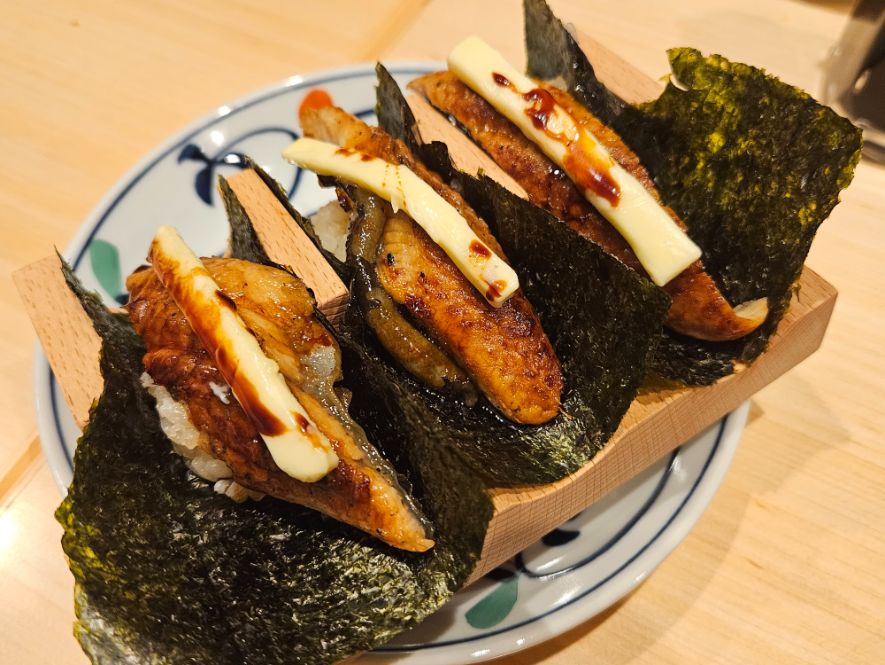
apanese people really have a fondness for adding butter to certain dishes. I still remember the first time I tried buttered corn ramen in Hokkaido; its rich and sweet flavor left a lasting impression on me. This time, I had the opportunity to taste Unagi Butter Sushi, once again marveling at the creativity of the Japanese culinary scene.

Unagi Butter Sushi was originally created by an innovative sushi restaurant in Osaka. It sparked discussions on social media and became one of the must-try sushi dishes in Osaka’s Umeda area. Now, you can also enjoy it in Namba! The combination of freshly grilled eel and rich butter may sound like it could overpower the delicate flavor of the eel, but surprisingly, the two complement each other perfectly, creating a delicious synergy where the whole is greater than the sum of its parts.
◆とうもろこしのかき揚げ Corn Tempura

This seemingly unassuming dish turned out to be one of the memorable appetizers of the day. “Toumorokoshi no Kakiage” is essentially fried corn, and my Chinese companion likened it to their corn fritters. As someone who had never tried corn fritters before, I found it quite intriguing. The crispy exterior and sweet interior of the corn made it a delightful snack suitable for all ages.
◆茶碗蒸しChawanmushi

Chawanmushi is a classic Japanese dish, typically made from a mixture of eggs, dashi (Japanese broth), soy sauce, and other seasonings. Essentially, it’s our version of steamed egg custard. However, Japanese-style chawanmushi tends to have a smoother texture and a simple yet incredibly satisfying taste that leaves a lasting impression.
◆海鮮ごま和え Seafood Gomae

Seafood gomae is another classic Japanese dish, made from various seafood and vegetables, topped with a special sesame sauce.
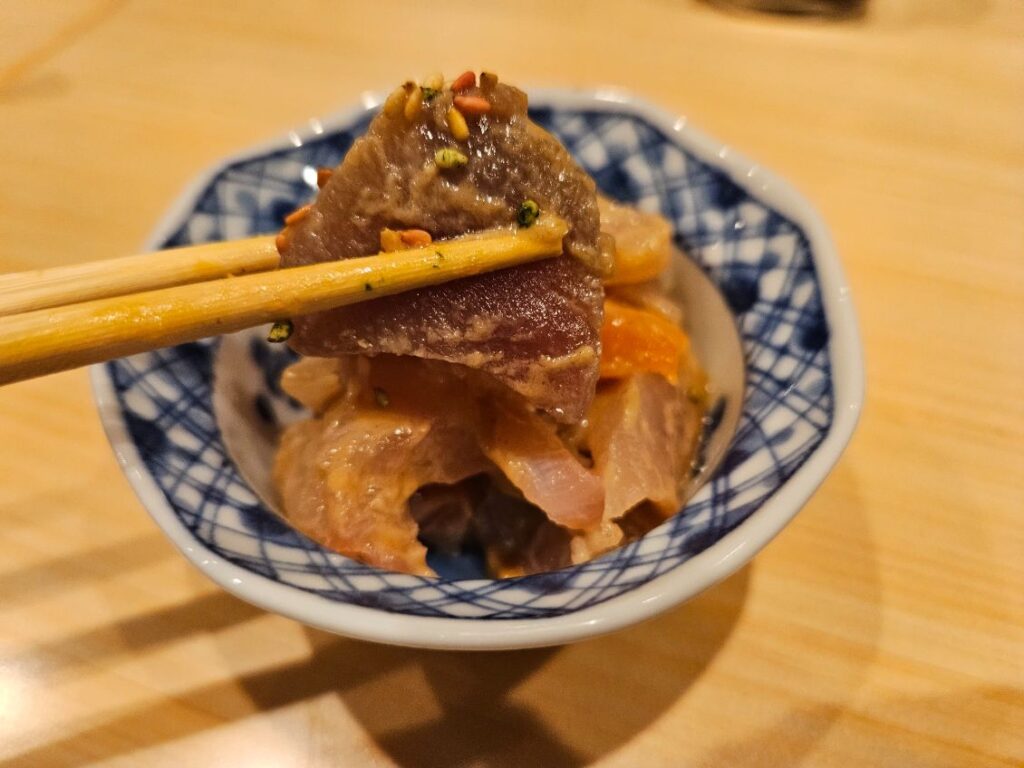
At first bite, the fragrance of the sesame sauce might seem a bit overpowering, but as you take another bite, you’ll find it becoming increasingly smooth and refreshing. Who would have thought that in addition to being enjoyed with wasabi and soy sauce, sashimi could also be paired with this delightful sesame sauce!
◆海鮮炸彈-海鮮バクダン Seafood Bomb – Kaisen Bakudan

海鮮バクダン Seafood Bakudan, translated as “seafood shumai” in the Chinese menu, intrigued me due to its illustration, which made it clear that this was not your typical shumai dumpling. Unable to resist my curiosity, I ordered a serving. “Bakudan” means “bomb” in Japanese, and there are two interpretations: one suggests that the yolk explodes in your mouth upon tasting, while the other implies that the explosion refers to the burst of flavor with each bite! This dish features sashimi salad with minced natto and okra. Before tasting, it’s recommended to drizzle a bit of soy sauce and mix thoroughly. The texture is exceptionally smooth and unique, but personally, I prefer the sesame seafood.
◆鰻巻きUnagi Maki
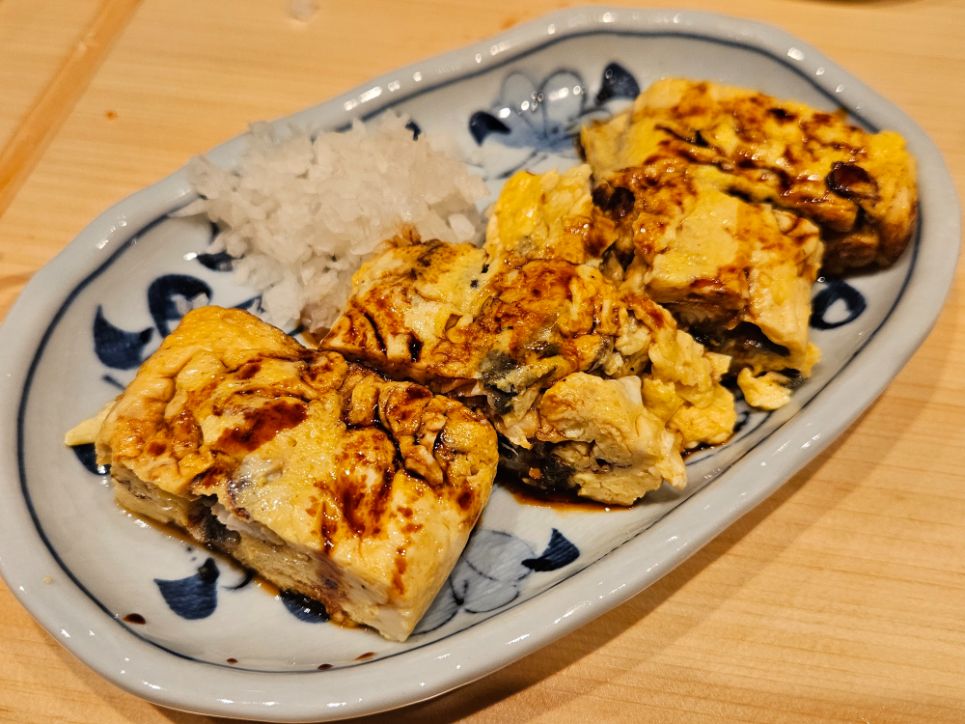
I initially thought Unagi Maki was an eel-flavored tamagoyaki (Japanese rolled omelet). However, the egg was incredibly soft and tender, unlike the firm texture of tamagoyaki. It was so soft that it was almost challenging to pick up with chopsticks. The highlight of this dish is the eel sauce, which adds a sweet and salty flavor, elevating the Unagi Maki to a whole new level.
◆Oden
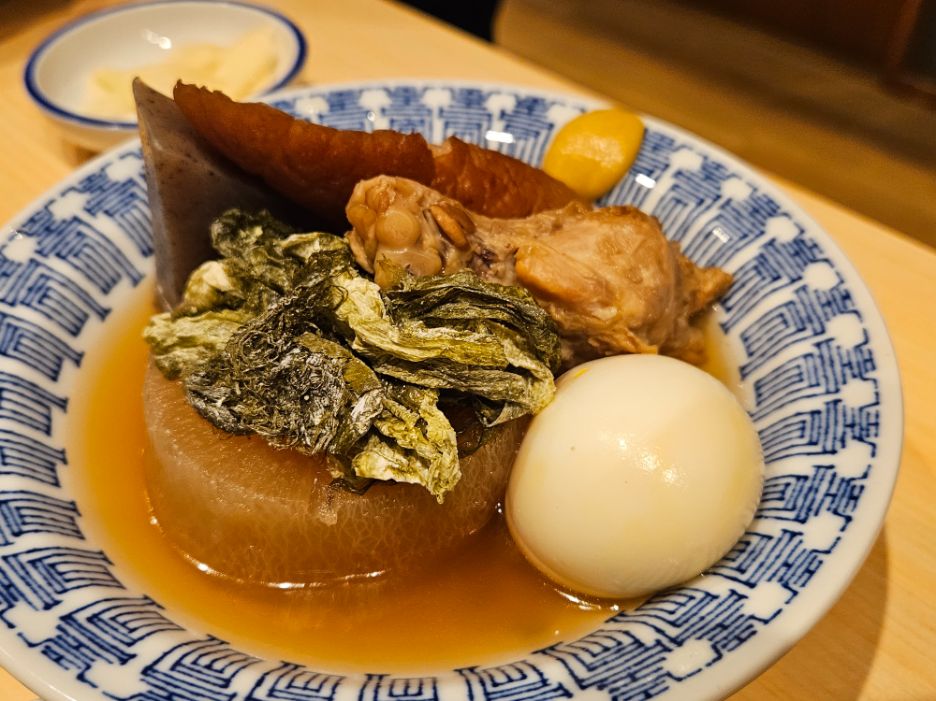
Oden needs no introduction. I’ve always heard that the flavor of oden differs between Kanto and Kansai regions, but I had never tasted it before. Finally, I got the chance to try it! The flavor of Kanto oden is typically richer and deeper in color. Here, the oden broth is made with shellfish, giving it a delightful sweetness. The dish contains konjac, chicken, boiled egg, radish, and fish cake. My favorite part was the boiled egg, with its soft yolk, unlike the dry yolks you sometimes find. On a chilly winter day, a steaming bowl of oden is sure to warm you up and leave you feeling satisfied.
◆播州赤穂サムライオイスターの牡蠣フライ Banshu Akashi Samurai Oyster Fry
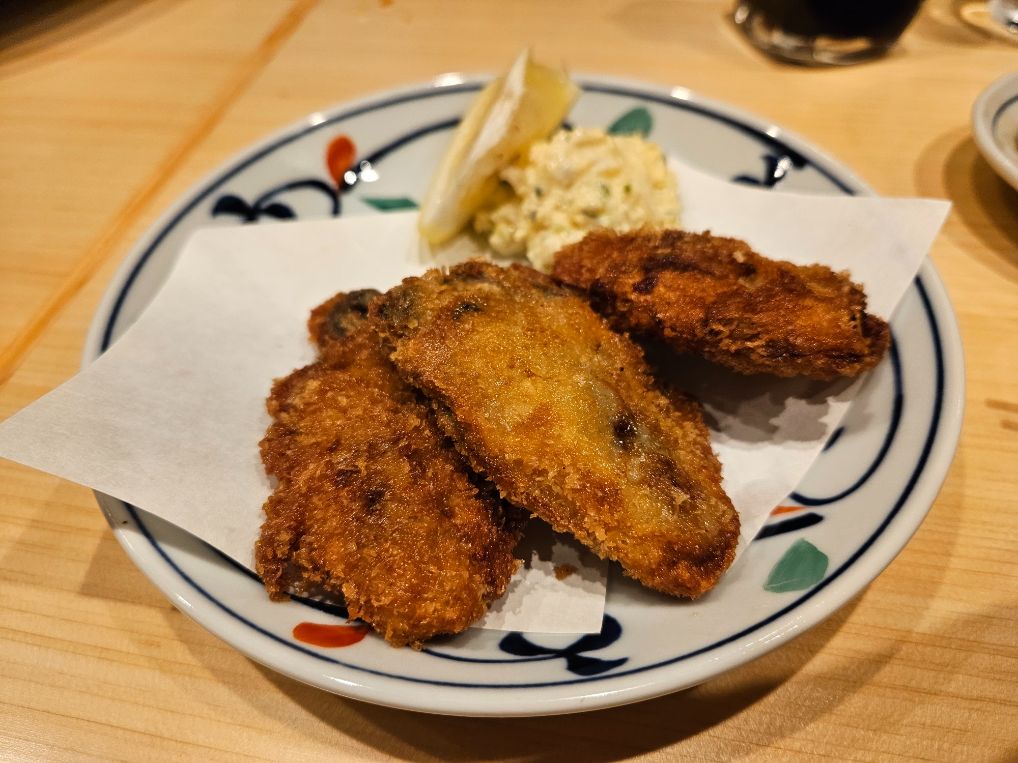
Fried oysters have always been one of my favorite Japanese dishes, so when I saw this dish on the menu, I knew I couldn’t pass it up! However, among the many dishes available, this one seemed to pale in comparison. Apart from being smaller and less plump in appearance, it didn’t have any particularly outstanding flavor. While I do enjoy fried oysters, I would recommend trying other more distinctive items at this izakaya.
Why recommend Sushitofuji Namba?
Location-wise, it’s conveniently situated with a wide variety of delicious dishes. Although the translation of the mobile ordering interface isn’t perfect, it has a thoughtful feature: the ability to split the bill directly! I hope they can improve the completeness of menu images and show who ordered what when placing orders, so there’s no need to worry about ordering duplicates. I really like this feature. Although there are no Chinese-speaking staff members in the restaurant, you can still enjoy yourself fully. The major plus point is the absence of “otoshi,” so you can allocate the budget for “otoshi” to order dishes you love!





